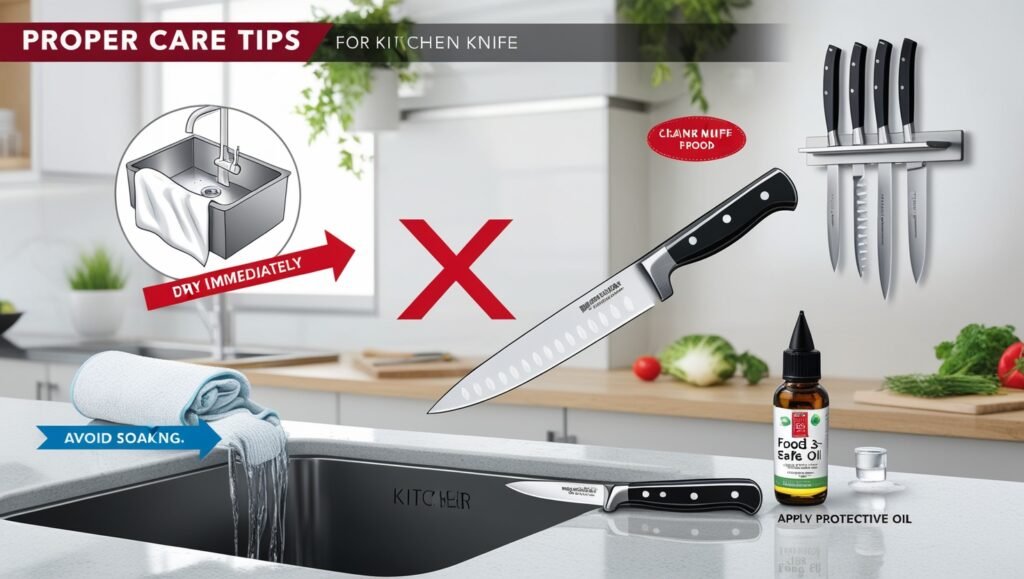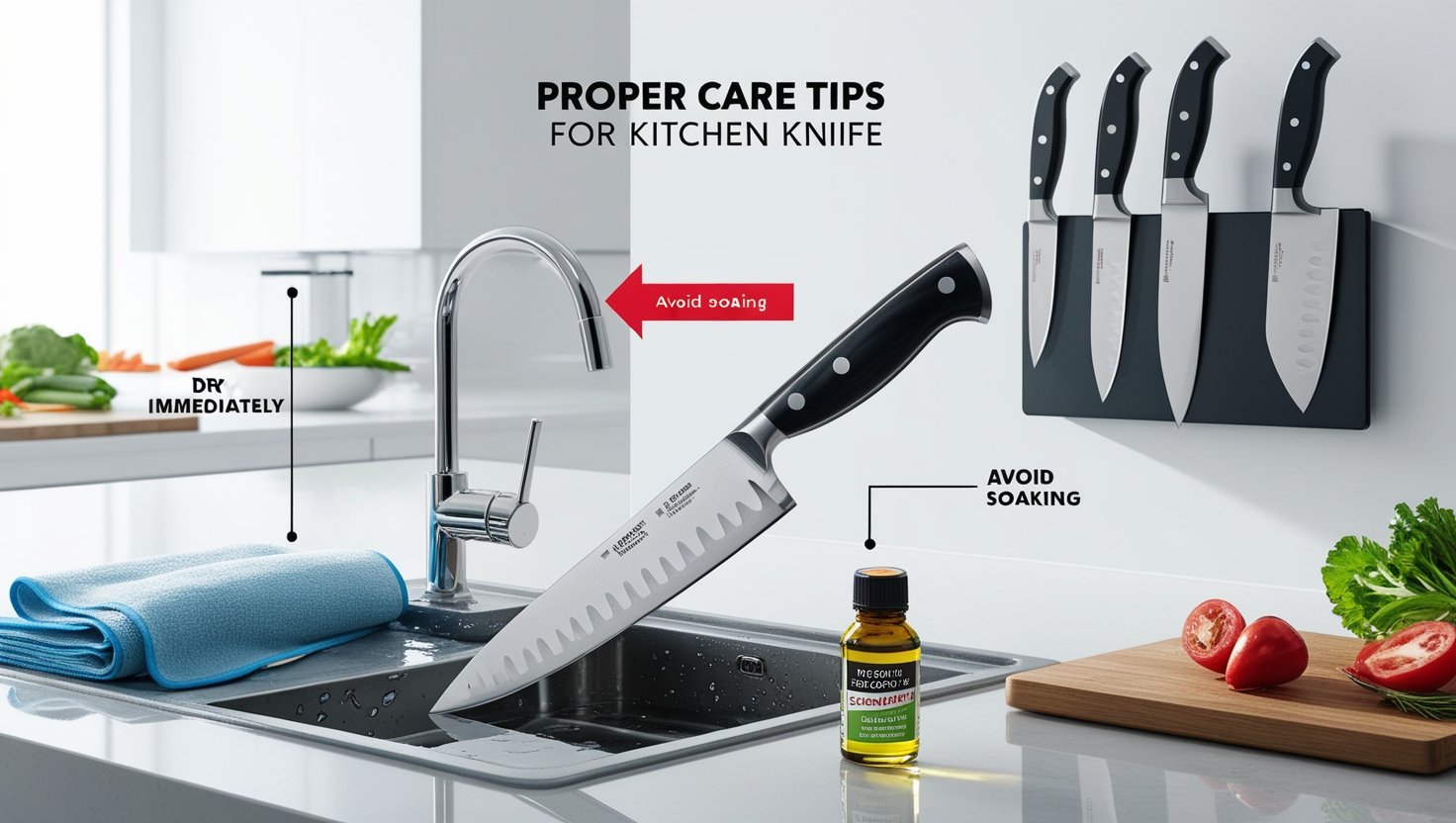How Long Can a Kitchen Knife Be Wet: Important Care Tips
Kitchen knives are indispensable tools in every kitchen. However, maintaining their quality and longevity requires proper care, especially when it comes to managing moisture. One common question is: how long can a kitchen knife be wet? This article provides insights and practical tips to ensure your knives remain in excellent condition.
Learn how long a kitchen knife can be wet and the best practices to prevent rust and damage. Keep your knives sharp, safe, and long-lasting with these essential care tips.
Is It Bad to Leave Knives Wet?
Yes, leaving knives wet can be detrimental to their condition. Extended contact with moisture can cause:
- Rust Formation: Even stainless steel knives can develop rust if left wet for too long. Water accelerates oxidation, weakening the blade.
- Handle Damage: Wooden or resin handles are particularly vulnerable to water, which can cause warping or cracking.
- Bacterial Growth: Moisture creates an ideal environment for bacteria, compromising food safety.
Knives should always be dried immediately after washing to prevent these issues.
Is It Bad to Let Knives Soak in Water?
 Yes, soaking knives in water is one of the worst practices. Extended soaking can:
Yes, soaking knives in water is one of the worst practices. Extended soaking can:
- Damage Handles: Wooden and glued handles are prone to separation and cracking.
- Weaken Blades: Continuous water exposure can lead to microscopic metal loss and dullness.
- Shorten Lifespan: Both blade and handle degrade faster when soaked.
Soaking knives not only risks physical damage but also poses a safety hazard when reaching into soapy water.
Is It Bad to Let Knives Air Dry?
Allowing knives to air dry may seem harmless, but it’s not ideal. Air drying:
- Encourages Rust: Residual water can linger, especially in crevices, leading to rust.
- Dulls Blades: The edge may become dulled with time due to exposure to air and moisture.
To avoid these issues, always dry your knife immediately after washing using a clean, soft towel.
How Long Can a Kitchen Knife Be Wet?
Ideally, a kitchen knife should not remain wet for more than 2-3 minutes. Beyond this, the risk of rust, dullness, and handle damage increases.
Overnight Wetness
Leaving a knife wet overnight can cause significant damage, including:
- Deep rust spots.
- Loosened handles.
- Compromised blade integrity.
The longer a knife stays wet, the harder it becomes to restore its original quality, potentially requiring professional sharpening or repairs.
Material Matters: Knife Types and Water Resistance
Different knife materials react differently to water exposure:
Stainless Steel
- Rust Resistance: High but not rust-proof.
- Maintenance: Dry immediately and store in a dry place.
Carbon Steel
- Rust Prone: Rusts quickly when wet.
- Care Tips: Oil the blade after drying to prevent oxidation.
Ceramic
- Rust-Free: Immune to rust but can chip easily.
- Care Tips: Handle with care and avoid soaking.
Understanding the properties of your knife material helps you tailor its care for optimal performance.
Safe Cleaning Practices
Proper cleaning is essential to maintain the longevity of your knives. Follow these steps:
Hand Washing
- Use warm water and mild soap.
- Pay attention to the blade and handle junction to remove food particles.
- Rinse thoroughly and dry immediately.
Dishwasher Warning
Avoid using a dishwasher. Harsh detergents and high temperatures can:
- Dull the blade.
- Damage the handle.
- Increase the risk of rust.
Knives jostling against other utensils can also chip or nick the blade.
Drying Techniques
Proper drying techniques are crucial:
Towel Drying
- Use a soft, lint-free towel.
- Wipe the blade from spine to edge.
- Ensure no moisture remains on the handle or blade junction.
Air Drying
- Place on a drying rack with good ventilation.
- Ensure complete dryness before storage.
Preventive Measures to Avoid Wet Knife Damage
- Store Properly: Use magnetic strips or knife blocks to keep knives dry and safe.
- Oil Regularly: Apply a thin coat of food-grade mineral oil to protect against rust.
- Use Cutting Boards: Avoid cutting on hard surfaces like glass or granite that can chip the blade.
Tips for Prolonging Knife Lifespan
- Clean Immediately: Wash your knife right after use to avoid food residue hardening.
- Sharpen Regularly: To keep the edge of the blade sharp, use a honing rod or whetstone.
- Avoid Dishwashers: Hand washing is the safest option for preserving both blade and handle.
By following these tips, you can ensure your knives remain functional and efficient for years.
Expert Recommendations
Professional chefs and manufacturers agree that proper care significantly extends a knife’s lifespan. Key tips include:
- Dry knives immediately after washing.
- Store knives in a dry, ventilated place.
- To keep the edge of the blade sharp, use a honing rod or whetstone.
Some manufacturers also recommend applying a light coat of oil after each use, particularly for high-carbon steel knives.
Common Mistakes to Avoid
- Leaving Knives in the Sink: This increases the risk of accidental cuts and water damage.
- Using Harsh Scrubbers: These can scratch the blade and reduce its sharpness.
- Improper Storage: Avoid tossing knives into drawers, where they can collide with other utensils.
Conclusion
Understanding how long a kitchen knife can be wet is vital for maintaining its performance and longevity. Avoid prolonged moisture exposure by drying knives immediately and storing them properly. With these care tips, your kitchen knives will remain sharp, rust-free, and ready for all your culinary tasks.
Proper maintenance not only protects your investment but also enhances your cooking experience, making every chop, slice, and dice smooth and efficient. Follow these guidelines to enjoy a lifetime of reliable kitchen knives.






